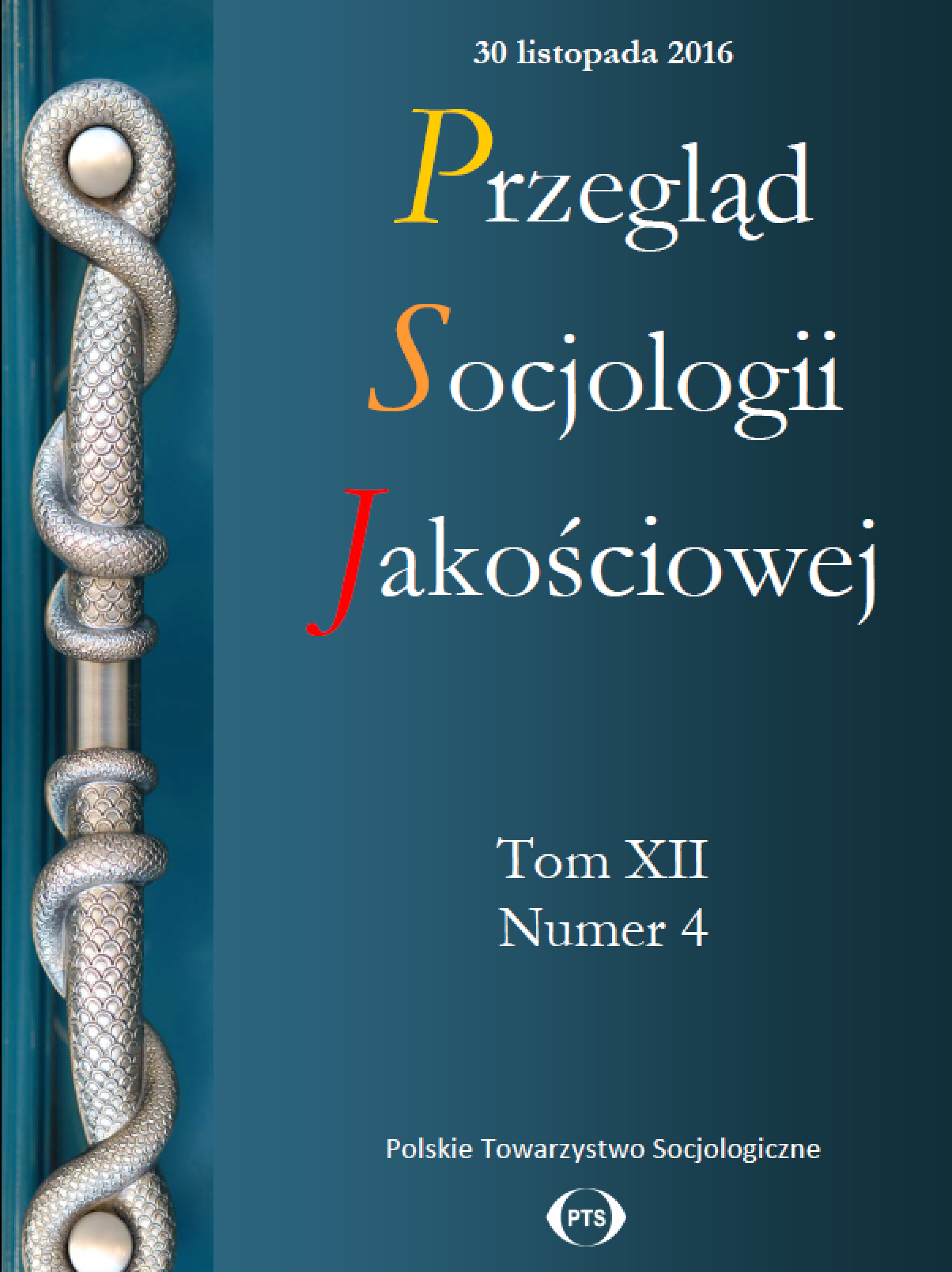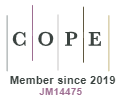Doświadczanie ciężarnego ciała jako ciała przekraczającego granice – studium socjologii ucieleśnienia
DOI:
https://doi.org/10.18778/1733-8069.12.4.06Słowa kluczowe:
ciało ciężarne, kobieta, doświadczanie, graniceAbstrakt
W artykule zaprezentowano, w oparciu o indywidualne wywiady pogłębione, doświadczanie ciężarnego ciała przez kobiety. Najczęściej ciężarne ciało jest przedmiotem zainteresowań naukowych albo jako przedmiot medykalizacji czy dyscyplinowania albo analizowane są jego reprezentacje. W tym artykule akcent przesunięty jest na doświadczanie, a tym samym wpisuje się on w rozważania prowadzone w ramach socjologii ucieleśnienia. Doświadczanie ciężarnego ciała, jako ciała o wyjątkowym statusie, łączącego w sobie dwa byty, jest analizowane poprzez odniesienie się do pojęcia granic i ich trzech wymiarów. Po pierwsze, interesuje mnie powiększanie się ciężarnego ciała, jego rozrastanie się i wynikające z tego zmiany codziennych praktyk kobiet oczekujących narodzin dziecka. Po drugie, granice ciężarnego ciała odnoszę do (nie)zależności ciała kobiety i rozwijającego się wewnątrz jej ciała dziecka. I wreszcie po trzecie, na przykładzie społecznej praktyki dotykania brzucha ciężarnej kobiety, analizuję granice prywatności i intymności ciężarnego ciała.
Pobrania
Bibliografia
Bailey Lucy (2001) Gender Shows: First-Time Mothers and Embodied Selves. „Gender and Society”, vol. 15, s. 110–129.
Google Scholar
DOI: https://doi.org/10.1177/089124301015001006
Bartky Sandra L. (2007) Foucault, kobiecość i unowocześnienie władzy patriarchalnej [w:] Renata E. Hryciuk, Agnieszka Kościańska, red., Gender: perspektywa antropologiczna, t. 2: Kobiecość, męskość, seksualność. Warszawa: Wydawnictwa UW, s. 50–75.
Google Scholar
Bordo Susan (1993) Unbearable Weight: Feminism, Western Culture, and the Body. Berkeley: University of California Press.
Google Scholar
Crossley Nick (2001) The Social Body. Habit, Identity and Desire. London, Thousand Oaks, New Delhi: SAGE Publications.
Google Scholar
Crossley Nick (2007) Researching Embodiment by Way of ‘Body Techniques’. „The Sociological Review”, vol. 55, s. 80–94.
Google Scholar
DOI: https://doi.org/10.1111/j.1467-954X.2007.00694.x
Csordas Thomas, ed. (1994) Embodiment and Experience: The Existential Ground of Culture and Self. Cambridge: Cambridge University Press.
Google Scholar
Douglas Mary (2007) Czystość i zmaza. Przełożyła Marta Bucholc. Warszawa: Państwowy Instytut Wydawniczy.
Google Scholar
Draper Jan (2003) Blurring, Moving and Broken Boundaries: Men’s Encounters with the Pregnant Body. „Sociology of Health & Illness”, vol. 25, s. 743–767.
Google Scholar
DOI: https://doi.org/10.1046/j.1467-9566.2003.00368.x
Drwięga Marek (2002) Ciało człowieka. Studium z antropologii filozoficznej. Kraków: Księgarnia Akademicka.
Google Scholar
Freund Peter (2001) Bodies, Disabilities and Spaces: the Social Model and Disabling Spatial Organisations. „Disability & Society”, vol. 16, no. 5, s. 689–706.
Google Scholar
DOI: https://doi.org/10.1080/09687590120070079
Glaser Barney (1978) Theoretical Sensitivity. San Francisco: The Sociology Press.
Google Scholar
Glaser Barney G., Strauss Anselm L. (1967) The Discovery of Grounded Theory: Strategies for Qualitative Research. Chicago: Aldine Publishing Company.
Google Scholar
Grosz Elizabeth (1994) Volatile Bodies: Toward a Corporeal Feminism. Bloomington: Indiana University Press.
Google Scholar
Hartouni Valerie (1991) Containing Women: Reproductive Discourse in the 1980s [w:] Constance Penley, Andrew Ross, eds., Technoculture. Minneapolis, MN: University of Minnesota Press, s. 27–56.
Google Scholar
Jakubowska Honorata (2009) Socjologia ciała. Poznań: Wydawnictwo Naukowe UAM.
Google Scholar
Jakubowska Honorata (2012) Ciało jako przedmiot badań socjologicznych – dylematy, pominięcia, możliwości. „Przegląd Socjologii Jakościowej”, t. 8, nr 2, s. 12–31 [dostęp 1 kwietnia 2016 r.]. Dostępny w Internecie http://www.przegladsocjologiijakosciowej.org
Google Scholar
DOI: https://doi.org/10.18778/1733-8069.8.2.02
Karpin Isabel (1992) Legislating the Female Body. „Columbia Journal of Gender and Law”, vol. 3, s. 325–349.
Google Scholar
Kaufmann Jean-Claude (2004) Ego. Socjologia jednostki. Przełożył Krzysztof Wakar. Warszawa: Oficyna Naukowa.
Google Scholar
Kember Sarah (1995) Medicine’s New Vision? [w:] Martin Lister, ed., The Photographic Image in Digital Culture. London: Routledge, s. 95–114.
Google Scholar
Kłonkowska Anna M., Gajewska Magdalena (2015) Belly-Stories. Feminine Stories About Body, Pregnancy and Childbirth. „Miscellanea Anthropologica et Sociologica”, vol. 16, s. 38–49.
Google Scholar
DOI: https://doi.org/10.5604/20842937.1150837
Konecki Krzysztof (2008) Wizualna teoria ugruntowana. Rodziny kodowania wykorzystywane w analizie wizualnej. „Przegląd Socjologii Jakościowej”, t. 4, nr 3 [dostęp 1 kwietnia 2016 r.]. Dostępny w Internecie http://www.qualitativesociologyreview.org/PL/archive_pl.php
Google Scholar
DOI: https://doi.org/10.18778/1733-8069.4.3.05
Kristeva Julia (1981) Women’s Time. „Signs: Journal of Women in Culture and Society”, vol. 7, s. 13–35.
Google Scholar
DOI: https://doi.org/10.1086/493855
Kristeva Julia (2007) Potęga obrzydzenia. Esej o wstręcie. Przełożył Maciej Falski. Kraków: Wydawnictwo Uniwersytetu Jagiellońskiego.
Google Scholar
Leder Drew (1990) Absent Body. Chicago: University of Chicago Press.
Google Scholar
Lewis Matthew (2013) How Does Pregnancy Transform the Embodied Self? [dostęp 25 lutego 2014 r.]. Dostępny w Internecie http://www.essex.ac.uk/sociology/documents/research/publications/ug_journal/vol10/2013SC394_MatthewLewis_FINAL. pdf
Google Scholar
Longhurst Robyn (2000) Bodies: Exploring Fluid Boundaries. London: Routledge.
Google Scholar
Longhurst Robyn (2001) Breaking Corporeal Boundaries: Pregnant Bodies in Public Places [w:] Ruth Holliday, John Hassards, eds., Contested Body. London: Routledge, s. 81–94.
Google Scholar
Lupton Deborah (2012) ‘Precious Cargo’: Foetal Subjects, Risk and Reproductive Citizenship. „Critical Public Health”, vol. 22, s. 329–340.
Google Scholar
DOI: https://doi.org/10.1080/09581596.2012.657612
MacKenzie Catriona (1992) Abortion and Embodiment. „Australasian Journal of Philosophy”, vol. 70, s. 136–155.
Google Scholar
DOI: https://doi.org/10.1080/00048409212345041
Majka-Rostek Dorota (2010) Wizerunek ciężarnego ciała [w:] Ewa Banaszak, Paweł Czajkowski, red., Corpus delicti – rozkoszne ciało. Szkice nie tylko z socjologii ciała. Warszawa: Difin, s. 187–203.
Google Scholar
Marody Mirosława, Giza-Poleszczuk Anna (2004) Przemiany więzi społecznych. Warszawa: Wydawnictwo Naukowe Scholar.
Google Scholar
Merleau-Ponty Maurice (2001). Fenomenologia percepcji. Przełożyli Małgorzata Kowalska i Jacek Migasiński, Warszawa: Fundacja Aletheia.
Google Scholar
Nash Meredith (2014) Picturing Mothers: A Photovoice Study of Body Image in Pregnancy. „Health Sociology Review”, vol. 23, s. 242–253.
Google Scholar
DOI: https://doi.org/10.1080/14461242.2014.11081977
Schmied Virginia, Lupton Deborah (2001) Blurring the Boundaries: Breastfeeding and Maternal Subjectivity. „Sociology of Health & Illness”, vol. 23, s. 234–250.
Google Scholar
DOI: https://doi.org/10.1111/1467-9566.00249
Westfall Rachel (2006) The Pregnant/Birthing Body: Negotiations of Personal Autonomy [w:] Dennis Waskul, Phillip Vannini, eds., Body/Embodiment: Symbolic Interaction and the Sociology of the Body. Aldershot–Burlington: Ashgate Publishing, s. 263–276.
Google Scholar
Wiant Cummins Molly (2014) Reproductive Surveillance: The Making of Pregnant Docile Bodies. „Kaleidoscope”, vol. 13, s. 33–51.
Google Scholar
Wolf Naomi (2014) Mit urody. Przełożyła Monika Rogowska- -Stangret. Warszawa: Czarna Owca.
Google Scholar
Young Iris Marion (2005) Pregnant Embodiment: Subjectivity and Alienation [w:] Iris Marion Young, ed., On Female Body Experience. “Throwing Like a Girl” and Other Essays. New York: Oxford University Press, s. 46–61.
Google Scholar
Pobrania
Opublikowane
Jak cytować
Numer
Dział
Licencja

Utwór dostępny jest na licencji Creative Commons Uznanie autorstwa – Użycie niekomercyjne – Bez utworów zależnych 4.0 Międzynarodowe.














